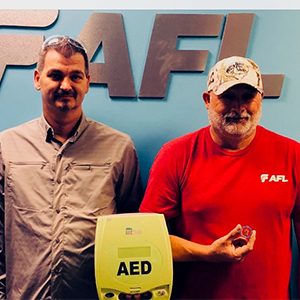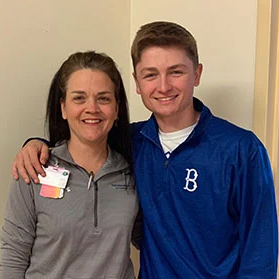Anything can happen. Anyone can help.

You're waiting in line at the grocery store when the woman in front of you suddenly falls to the floor. You exchange looks with the store clerk, who yells for someone to call 9-1-1. People nearby look at you with concern. Like them, you secretly hope someone else steps forward to help. But being the closest, you try to help. “Are you ok? Miss! Are you ok?” You shake her shoulder, beginning to realize the gravity of the situation. Getting no response, you stay with her and wait, hoping that help comes quickly.
With just a bit of planning, we can all be ready to do more than simply wait and hope.
Anything can happen
Events like this occur everyday. A supervisor cuts his leg on the job, causing severe bleeding. A teenager suffers sudden cardiac arrest (SCA) during football practice. A man suddenly collapses at the gym.
- Injury-related emergency department visits in the U.S. reached 35 million in 2018, according to the U.S. Centers for Disease Control and Prevention (CDC).
- Traumatic injuries are a leading cause of death and disability and approximately 40% of trauma-related deaths are caused by uncontrolled bleeding.
- In the U.S. each year, it's estimated there are more than 356,000 incidents — almost 1,000 per day — of out-of-hospital cardiac arrest (OHCA). Nearly 90% of OHCA victims don't survive.
In any emergency, contacting emergency medical services (EMS) immediately is a critical first step, but it may take 7 to 14 minutes1 for them to arrive.
Without immediate medical help, many incidents can quickly take a turn for the worst. Severe bleeding can become fatal in 3 to 5 minutes. Airway complications can cause hypoxic brain death in as few as 6 minutes. Without intervention, an SCA victim's chance of survival decreases by 10% every minute.

Anyone can help
When organizations are prepared with the right equipment and bystanders have the confidence to step in, anyone can help provide care when time is of the essence. But what does that preparation entail?
Every rescue really begins well in advance of an incident — when a business owner, health and safety manager, facility manager, or school nurse demonstrates a commitment to safety by purchasing and installing AEDs and mobile trauma kits and implementing a response plan.
More than just equipment installation, a response plan incorporates support and program management services that ensure equipment is maintained and consumables are up-to-date. It also integrates CPR, AED, and first aid training, giving individuals the confidence to step in when there's a call for help.
And data shows that outcomes improve when they do.
SCA victims who receive CPR and defibrillation show up to a 60% survival rate. And tourniquets are shown to be an effective way to control life-threatening bleeding.
Read about real people who stepped in to help quickly and confidently while waiting for EMS to arrive:



Most of the bystanders in these stories had no professional medical training and most had never used an AED or a trauma kit. All later remarked how easy the rescue equipment was to use and how clear the instructions were, despite the stress of a medical emergency. With guidance and feedback from an AED or the Mobilize app in a trauma kit, rescuers knew they were taking the appropriate steps and performing them correctly and effectively.
Hope is in your hands
Imagine, once again, that woman in line at the grocery store. Wouldn't you feel confident knowing you've taken steps to reduce uncertainty, encourage bystander intervention, and ensure your workplace is prepared when every minute counts? By empowering the people in your organization with tools, program management, and training, anyone can help save a life.
Learn about the steps you can take to develop and implement an emergency response plan, install emergency equipment, and ensure you have adequate program management support to manage training and consumables. Make sure your employees and those who visit your organization have access to the equipment they need in the moments before EMS arrives.
Be ready for anything to happen and make sure anyone can help.
1Mell HK, et al. JAMA Surg. 2017;152:10:983–984. doi:10.1001/jamasurg.2017.2230.

